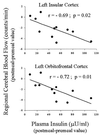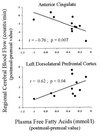Neuroanatomical correlates of hunger and satiation in humans using positron emission tomography
- PMID: 10200303
- PMCID: PMC16373
- DOI: 10.1073/pnas.96.8.4569
Neuroanatomical correlates of hunger and satiation in humans using positron emission tomography
Abstract
The central role of the hypothalamus in the origination and/or processing of feeding-related stimuli may be modulated by the activity of other functional areas of the brain including the insular cortex (involved in enteroceptive monitoring) and the prefrontal cortex (involved in the inhibition of inappropriate response tendencies). Regional cerebral blood flow (rCBF), a marker of neuronal activity, was measured in 11 healthy, normal-weight men by using positron emission tomography in a state of hunger (after 36-h fast) and a state of satiation (after a liquid meal). Hunger was associated with significantly increased rCBF in the vicinity of the hypothalamus and insular cortex and in additional paralimbic and limbic areas (orbitofrontal cortex, anterior cingulate cortex, and parahippocampal and hippocampal formation), thalamus, caudate, precuneus, putamen, and cerebellum. Satiation was associated with increased rCBF in the vicinity of the ventromedial prefrontal cortex, dorsolateral prefrontal cortex, and inferior parietal lobule. Changes in plasma insulin concentrations in response to the meal were negatively correlated with changes in rCBF in the insular and orbitofrontal cortex. Changes in plasma free fatty acid concentrations in response to the meal were negatively correlated with changes in rCBF in the anterior cingulate and positively correlated with changes in rCBF in the dorsolateral prefrontal cortex. In conclusion, these findings raise the possibility that several regions of the brain participate in the regulation of hunger and satiation and that insulin and free fatty acids may be metabolic modulators of postprandial brain neuronal events. Although exploratory, the present study provides a foundation for investigating the human brain regions and cognitive operations that respond to nutritional stimuli.
Figures



Similar articles
-
Sex differences in the human brain's response to hunger and satiation.Am J Clin Nutr. 2002 Jun;75(6):1017-22. doi: 10.1093/ajcn/75.6.1017. Am J Clin Nutr. 2002. PMID: 12036808
-
Differential brain responses to satiation in obese and lean men.Diabetes. 2000 May;49(5):838-46. doi: 10.2337/diabetes.49.5.838. Diabetes. 2000. PMID: 10905495
-
Effect of satiation on brain activity in obese and lean women.Obes Res. 2001 Nov;9(11):676-84. doi: 10.1038/oby.2001.92. Obes Res. 2001. PMID: 11707534
-
Neuroimaging and obesity: mapping the brain responses to hunger and satiation in humans using positron emission tomography.Ann N Y Acad Sci. 2002 Jun;967:389-97. Ann N Y Acad Sci. 2002. PMID: 12079866 Review.
-
Regional cerebral blood flow in depression measured by positron emission tomography: the relationship with clinical dimensions.Psychol Med. 1993 Aug;23(3):579-90. doi: 10.1017/s0033291700025368. Psychol Med. 1993. PMID: 7901863 Review.
Cited by
-
Whole-brain functional connectivity correlates of obesity phenotypes.Hum Brain Mapp. 2020 Dec;41(17):4912-4924. doi: 10.1002/hbm.25167. Epub 2020 Aug 17. Hum Brain Mapp. 2020. PMID: 32804441 Free PMC article.
-
Influencing the body schema through the feeling of satiety.Sci Rep. 2022 Feb 11;12(1):2350. doi: 10.1038/s41598-022-06331-3. Sci Rep. 2022. PMID: 35149735 Free PMC article.
-
Repeated Transcranial Direct Current Stimulation Induces Behavioral, Metabolic and Neurochemical Effects in Rats on High-Calorie Diet.Front Behav Neurosci. 2018 Jan 15;11:262. doi: 10.3389/fnbeh.2017.00262. eCollection 2017. Front Behav Neurosci. 2018. PMID: 29379423 Free PMC article.
-
Limitation of physical performance in a muscle fatiguing handgrip exercise is mediated by thalamo-insular activity.Hum Brain Mapp. 2011 Dec;32(12):2151-60. doi: 10.1002/hbm.21177. Epub 2010 Dec 10. Hum Brain Mapp. 2011. PMID: 21154789 Free PMC article.
-
Differential effects of hunger and satiety on insular cortex and hypothalamic functional connectivity.Eur J Neurosci. 2016 May;43(9):1181-9. doi: 10.1111/ejn.13182. Epub 2016 Feb 20. Eur J Neurosci. 2016. PMID: 26790868 Free PMC article.
References
-
- Levin B E, Routh V H. Am J Physiol. 1996;271:R491–R500. - PubMed
-
- Oomura Y. In: Handbook of the Hypothalamus: Physiology of the Hypothalamus. Morgane P J, Panksepp J, editors. New York: Dekker; 1981. pp. 557–620.
-
- Kuenzel W J. J Nutr. 1994;124:1355S–1370S. - PubMed
-
- Stellar E. Psychol Rev. 1954;61:5–22. - PubMed
MeSH terms
Substances
LinkOut - more resources
Full Text Sources
Other Literature Sources

